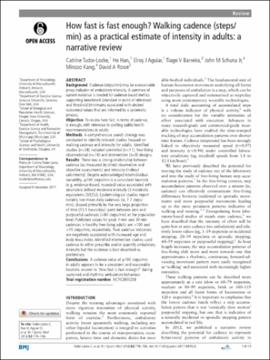| dc.contributor.author | Tudor-Locke, Catrine | |
| dc.contributor.author | Han, Ho | |
| dc.contributor.author | Aguiar, Elroy J. | |
| dc.contributor.author | Barreira, Tiago V. | |
| dc.contributor.author | Schuna, John M., Jr. | |
| dc.contributor.author | Kang, Minsoo | |
| dc.contributor.author | Rowe, David A. | |
| dc.date.accessioned | 2022-04-19T20:21:00Z | |
| dc.date.available | 2022-04-19T20:21:00Z | |
| dc.date.issued | 2018-05-31 | |
| dc.identifier | oksd_han_howfastisfastenough_2018 | |
| dc.identifier.citation | Tudor-Locke, C., Han, H., Aguiar, E. J., Barreira, T. V., Schuna, J. M., Kang, M., & Rowe, D. A. (2018). How fast is fast enough? Walking cadence (steps/min) as a practical estimate of intensity in adults: A narrative review. British Journal of Sports Medicine, 52(12), pp. 776-788. https://doi.org/10.1136/bjsports-2017-097628 | |
| dc.identifier.uri | https://hdl.handle.net/11244/335267 | |
| dc.description.abstract | Background: Cadence (steps/min) may be a reasonable proxy-indicator of ambulatory intensity. A summary of current evidence is needed for cadence-based metrics supporting benchmark (standard or point of reference) and threshold (minimums associated with desired outcomes) values that are informed by a systematic process. | |
| dc.description.abstract | Objective: To review how fast, in terms of cadence, is enough, with reference to crafting public health recommendations in adults. | |
| dc.description.abstract | Methods: A comprehensive search strategy was conducted to identify relevant studies focused on walking cadence and intensity for adults. Identified studies (n=38) included controlled (n=11), free-living observational (n=18) and intervention (n=9) designs. | |
| dc.description.abstract | Results: There was a strong relationship between cadence (as measured by direct observation and objective assessments) and intensity (indirect calorimetry). Despite acknowledged interindividual variability, =100 steps/min is a consistent heuristic (e.g., evidence-based, rounded) value associated with absolutely defined moderate intensity (3 metabolic equivalents (METs)). Epidemiological studies report notably low mean daily cadences (ie, 7.7 steps/min), shaped primarily by the very large proportion of time (13.5 hours/day) spent between zero and purposeful cadences (<60 steps/min) at the population level. Published values for peak 1-min and 30-min cadences in healthy free-living adults are >100 and >70 steps/min, respectively. Peak cadence indicators are negatively associated with increased age and body mass index. Identified intervention studies used cadence to either prescribe and/or quantify ambulatory intensity but the evidence is best described as preliminary. | |
| dc.description.abstract | Conclusions: A cadence value of =100 steps/min in adults appears to be a consistent and reasonable heuristic answer to 'How fast is fast enough?' during sustained and rhythmic ambulatory behaviour. | |
| dc.format | application/pdf | |
| dc.language | en_US | |
| dc.publisher | BMJ | |
| dc.relation.ispartof | British Journal of Sports Medicine, 52 (12) | |
| dc.relation.uri | https://www.ncbi.nlm.nih.gov/pubmed/29858465 | |
| dc.rights | This material has been previously published. In the Oklahoma State University Library's institutional repository this version is made available through the open access principles and the terms of agreement/consent between the author(s) and the publisher. The permission policy on the use, reproduction or distribution of the material falls under fair use for educational, scholarship, and research purposes. Contact Digital Resources and Discovery Services at lib-dls@okstate.edu or 405-744-9161 for further information. | |
| dc.subject.mesh | Exercise | |
| dc.subject.mesh | Health Behavior | |
| dc.subject.mesh | Humans | |
| dc.subject.mesh | Observational Studies as Topic | |
| dc.subject.mesh | Walking Speed | |
| dc.title | How fast is fast enough? Walking cadence (steps/min) as a practical estimate of intensity in adults: A narrative review | |
| dc.date.updated | 2022-04-12T18:23:28Z | |
| osu.filename | oksd_han_howfastisfastenough_2018.pdf | |
| dc.description.peerreview | Peer reviewed | |
| dc.identifier.doi | 10.1136/bjsports-2017-097628 | |
| dc.description.department | Community Health Sciences, Counseling and Counseling Psychology | |
| dc.type.genre | Article | |
| dc.type.material | Text | |
| dc.subject.keywords | exercise | |
| dc.subject.keywords | physical activity | |
| dc.subject.keywords | walking | |
| dc.subject.keywords | Clinical Research | |
| dc.subject.keywords | Generic health relevance | |
| dc.subject.keywords | 09 Engineering | |
| dc.subject.keywords | 11 Medical and Health Sciences | |
| dc.subject.keywords | 13 Education | |
| dc.subject.keywords | Sport Sciences | |
| dc.rights.license | https://creativecommons.org/licenses/by/4.0/ | |
| dc.identifier.author | ScopusID: 7003557760 (Tudor-Locke, C) | |
| dc.identifier.author | ORCID: 0000-0003-4241-7317 (Han, H) | |
| dc.identifier.author | ScopusID: 57191291072 (Han, H) | |
| dc.identifier.author | ScopusID: 36166452400 (Aguiar, EJ) | |
| dc.identifier.author | ScopusID: 26634737300 (Barreira, TV) | |
| dc.identifier.author | ScopusID: 36802535500 (Schuna, JM) | |
| dc.identifier.author | ScopusID: 37000930200 (Kang, M) | |
| dc.identifier.author | ScopusID: 57201097839 (Rowe, DA) | |
